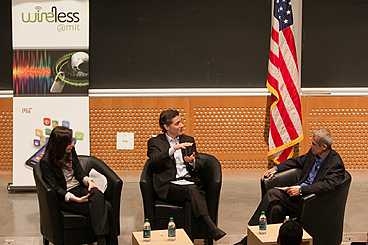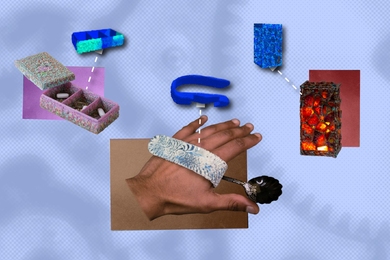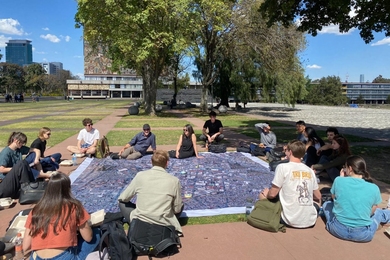On March 6, the MIT Center for Wireless Networks and Mobile Computing (Wireless@MIT) kicked off its new lecture series with a discussion on wireless spectrum policy with Federal Communications Commission (FCC) Chairman Julius Genachowski. Professors Hari Balakrishnan and Dina Katabi, co-directors of Wireless@MIT, spoke with Genachowski on topics ranging from America’s performance in the broadband market to the importance of wireless policy, followed by questions from audience members who packed into the Kirsch Auditorium in the Stata Center.
Genachowski kicked off the event by explaining his own personal connection to MIT. A native of Brookline, Mass., Genachowski’s father received his master’s in mechanical engineering at the Institute. Genachowski recalled how as a teenager his father took him on a trip to MIT, specifically the Barker Engineering Library. There he showed Genachowski his thesis, which outlined plans for a device that could help blind people read the words on a page by translating the text into physical signals. While his father’s plans never came to fruition, Genachowski was inspired by the work, which showed him the power of communications technology to help people. It’s an ideal that continues to motivate his work to this day.
In his remarks, Genachowski noted America’s recent achievements in broadband. Four years ago, Genachowski explained, much of the activity and innovations in the mobile field were happening in countries like Japan. Today the United States “has leapfrogged other countries,” Genachowski said, and much of the innovation in the wireless field stems from this country, especially in areas like the creation of new mobile applications and 4G usage.
There remains a need for “forward-looking spectrum policies,” he said, due to the increased demand and growth in wireless. In order for the United States. to continue to lead the wireless movement and to meet current demands, more spectrum must be freed up, Internet openness must be preserved and the speed and capacity of wired and wireless networks must be increased.
“Spectrum is essential infrastructure for our modern economy,” Genachowski said when asked about the importance of wireless spectrum policy. “Mobile infrastructure does not work without spectrum.”
Genachowski referenced two innovations in wireless policy that helped pave the way for today’s mobile environment: The introduction of spectrum auctions and unlicensed spectrum use. According to Genachowski, the U.S. needs more policies like these — including incentive auctions, more efficient use of spectrum and sharing of government spectrum — to help develop the next generation of wireless technologies.
He added that he expects the introduction of incentivized auctions, which would allow television broadcasters to sell unused spectrum, will free up a significant amount of spectrum for licensed and unlicensed use. Genachowski also announced plans to allow for nationwide use of white spaces, or spectrum allocated to a broadcasting company that is not in use.
Genachowski credited the availability of unlicensed spectrum as providing a platform for researchers to develop such technologies as Bluetooth and Wi-Fi, and expressed hopes that this technological innovation will continue.
Taking questions from the audience, Genachowski spoke on everything from the planned expansion of the 5 GHz bandwidth to whether he believes an engineer would make a good FCC commissioner (yes). When asked about the benefits of communications technology in helping people with disabilities, Genachowski explained that the FCC is currently working on changing the process so that the needs of people with disabilities are taken into consideration earlier in the research and development process.
When asked about what would happen if there was not sufficient spectrum to meet current demands, Genachowski credited MIT researchers for tackling the problem. “There is research going on at MIT that goes directly at this problem,” Genachowski said, referencing new projects at Wireless@MIT that improve the quality of video streaming, allow for spectrum sharing and increase throughput in wireless networks.
Wireless@MIT, based in the MIT Computer Science and Artificial Intelligence Lab (CSAIL), was launched last October with the goal of addressing the most important challenges facing the wireless and mobile computing fields, in particular the spectrum crunch. Researchers aim to develop new techniques for overcoming the exhaustion of radio airwaves, or spectrum, caused by the explosive popularity of wireless systems.
Genachowski kicked off the event by explaining his own personal connection to MIT. A native of Brookline, Mass., Genachowski’s father received his master’s in mechanical engineering at the Institute. Genachowski recalled how as a teenager his father took him on a trip to MIT, specifically the Barker Engineering Library. There he showed Genachowski his thesis, which outlined plans for a device that could help blind people read the words on a page by translating the text into physical signals. While his father’s plans never came to fruition, Genachowski was inspired by the work, which showed him the power of communications technology to help people. It’s an ideal that continues to motivate his work to this day.
In his remarks, Genachowski noted America’s recent achievements in broadband. Four years ago, Genachowski explained, much of the activity and innovations in the mobile field were happening in countries like Japan. Today the United States “has leapfrogged other countries,” Genachowski said, and much of the innovation in the wireless field stems from this country, especially in areas like the creation of new mobile applications and 4G usage.
There remains a need for “forward-looking spectrum policies,” he said, due to the increased demand and growth in wireless. In order for the United States. to continue to lead the wireless movement and to meet current demands, more spectrum must be freed up, Internet openness must be preserved and the speed and capacity of wired and wireless networks must be increased.
“Spectrum is essential infrastructure for our modern economy,” Genachowski said when asked about the importance of wireless spectrum policy. “Mobile infrastructure does not work without spectrum.”
Genachowski referenced two innovations in wireless policy that helped pave the way for today’s mobile environment: The introduction of spectrum auctions and unlicensed spectrum use. According to Genachowski, the U.S. needs more policies like these — including incentive auctions, more efficient use of spectrum and sharing of government spectrum — to help develop the next generation of wireless technologies.
He added that he expects the introduction of incentivized auctions, which would allow television broadcasters to sell unused spectrum, will free up a significant amount of spectrum for licensed and unlicensed use. Genachowski also announced plans to allow for nationwide use of white spaces, or spectrum allocated to a broadcasting company that is not in use.
Genachowski credited the availability of unlicensed spectrum as providing a platform for researchers to develop such technologies as Bluetooth and Wi-Fi, and expressed hopes that this technological innovation will continue.
Taking questions from the audience, Genachowski spoke on everything from the planned expansion of the 5 GHz bandwidth to whether he believes an engineer would make a good FCC commissioner (yes). When asked about the benefits of communications technology in helping people with disabilities, Genachowski explained that the FCC is currently working on changing the process so that the needs of people with disabilities are taken into consideration earlier in the research and development process.
When asked about what would happen if there was not sufficient spectrum to meet current demands, Genachowski credited MIT researchers for tackling the problem. “There is research going on at MIT that goes directly at this problem,” Genachowski said, referencing new projects at Wireless@MIT that improve the quality of video streaming, allow for spectrum sharing and increase throughput in wireless networks.
Wireless@MIT, based in the MIT Computer Science and Artificial Intelligence Lab (CSAIL), was launched last October with the goal of addressing the most important challenges facing the wireless and mobile computing fields, in particular the spectrum crunch. Researchers aim to develop new techniques for overcoming the exhaustion of radio airwaves, or spectrum, caused by the explosive popularity of wireless systems.






